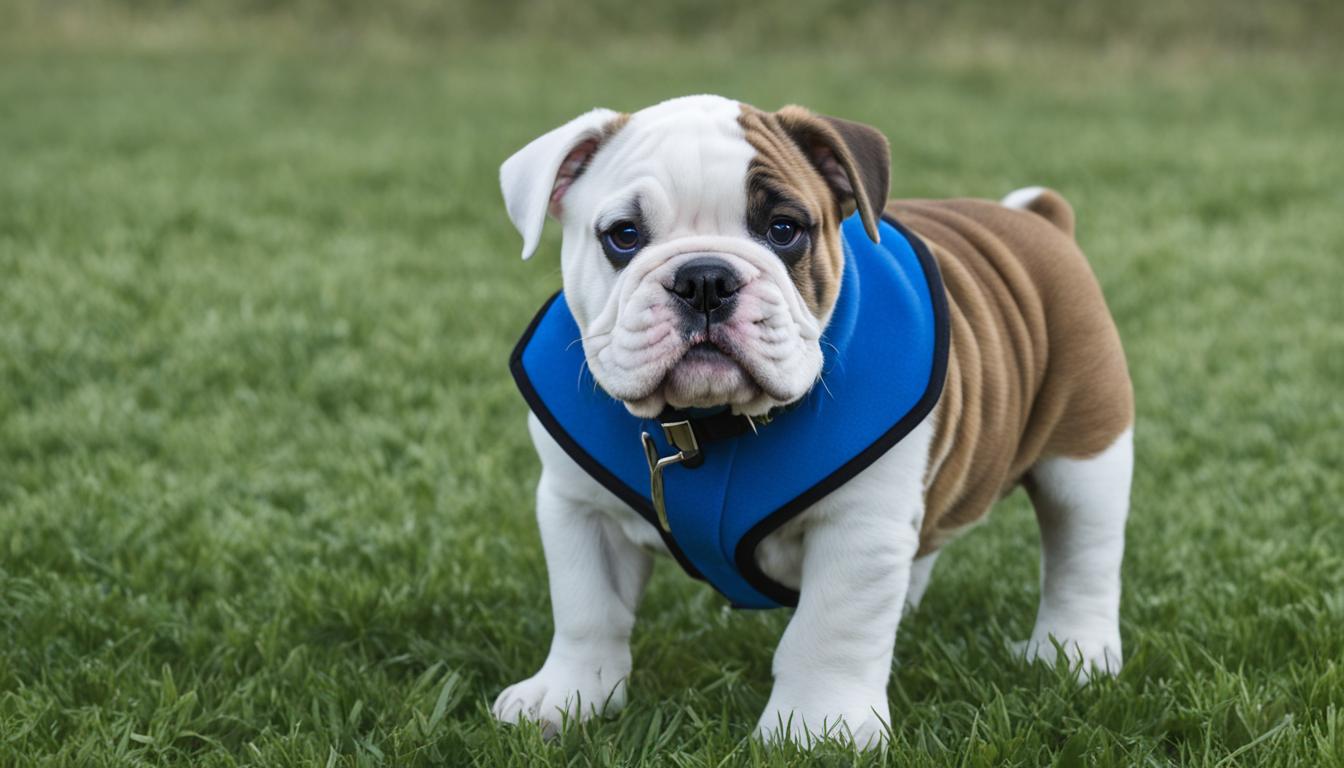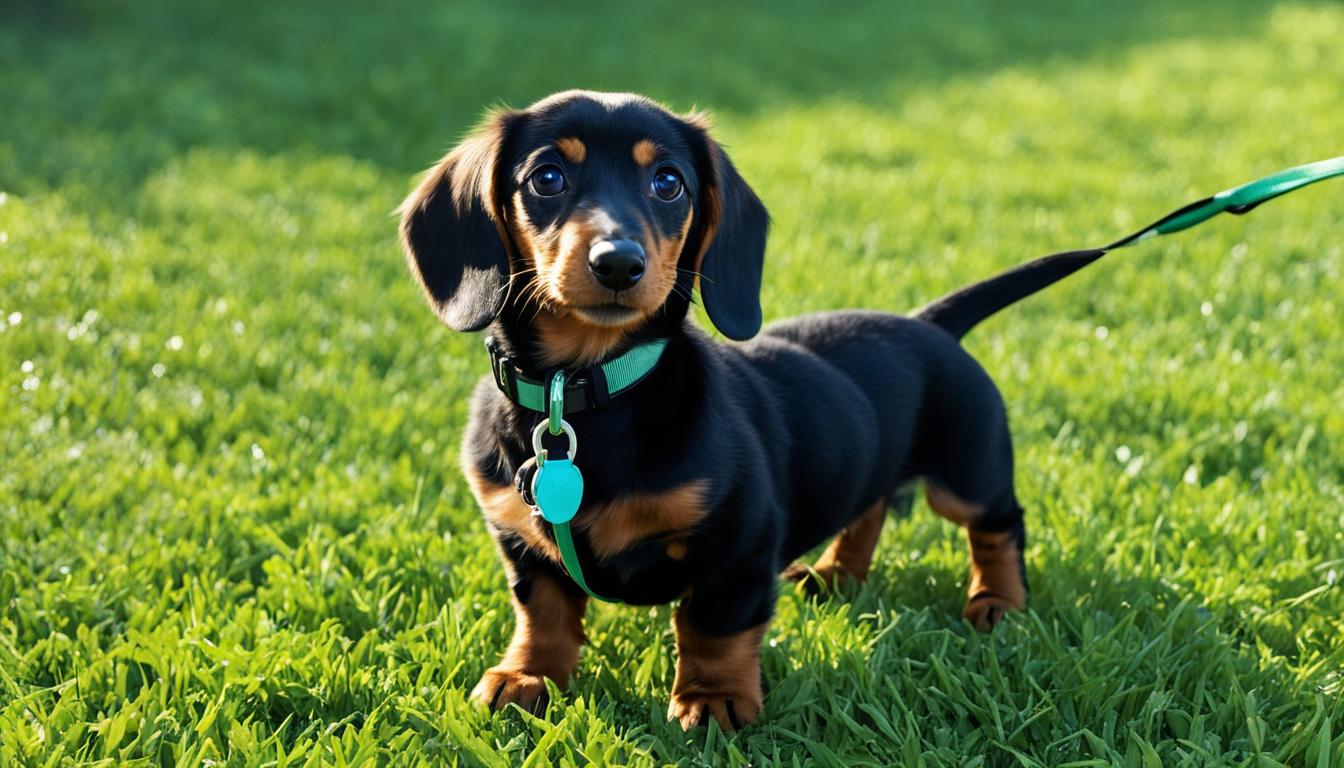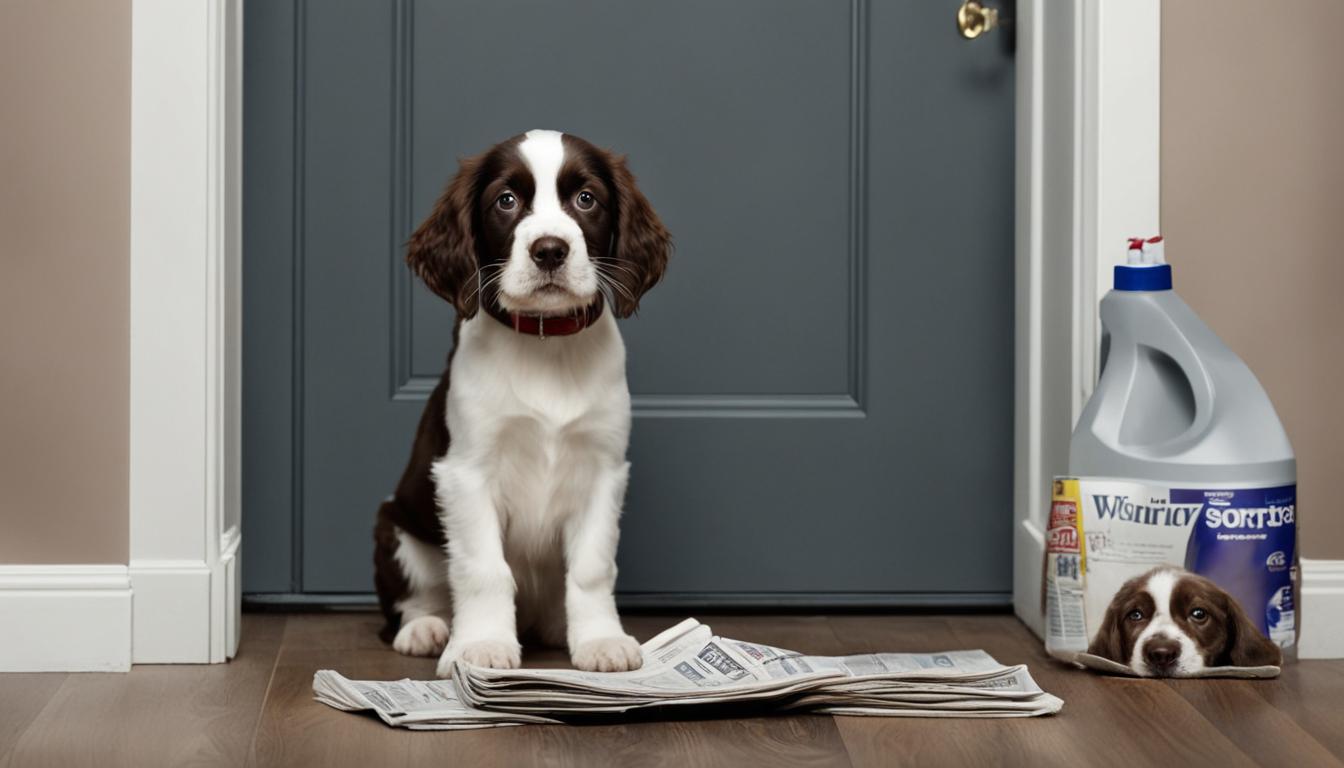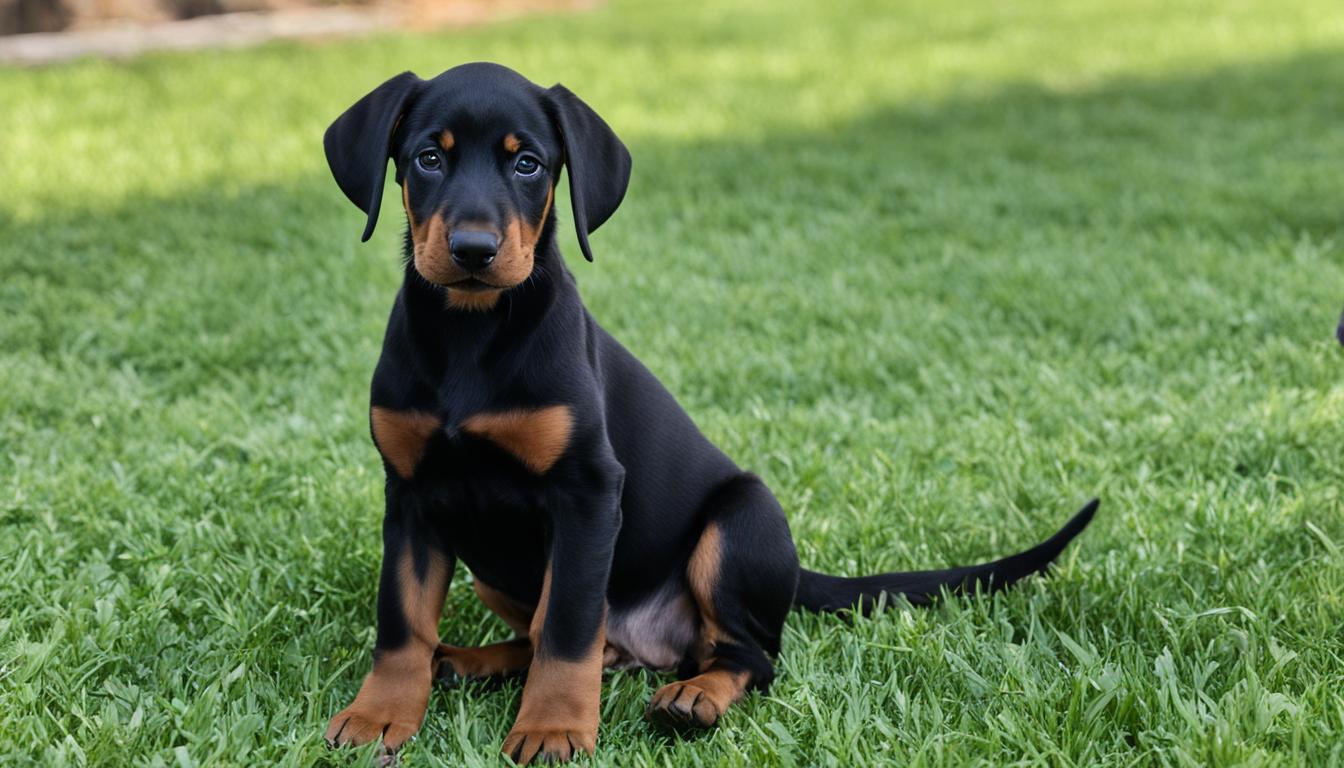Embarking on the noble journey of housebreaking English Bulldogs can be both a challenging and rewarding endeavor. Bringing home that squishy-faced bundle of joy comes with no shortage of slobbery kisses and tail wags, but also the critical task of potty training. Trips outside may be frequent at first, but with the right English Bulldog puppy potty training guide by your side, you’ll soon have your pup managing their house manners like a pro.
The key to success lies in crate training techniques for puppies, which leverage their instinct to keep their sleeping area clean. Assemble the ideal crate haven, and use it as a cornerstone of your housebreaking efforts. Your faithful companion yearns for structure, so establishing a consistent potty break schedule for puppies is essential. And don’t forget, showering your English Bulldog with praise taps into the power of positive reinforcement in puppy training, transforming a potentially stressful experience into an exciting opportunity to bond.
Stay tuned, as we unravel the mysteries of potty training your English Bulldog puppy, and help you forge a path toward a clean, happy home filled with mutual respect and understanding between you and your furry friend.
What Are The Benefits of Potty Training Your English Bulldog Puppy?
As a dedicated English Bulldog owner, delving into the potty training journey is about much more than sparing your rugs from untidy accidents. It’s a pivotal stage in your furry companion’s behavioral development, shaping habits that will benefit both their hygiene and overall demeanor. By initiating these good practices, you’re not just preventing indoor accidents, but also fostering a structured environment that supports your Bulldog’s innate need for cleanliness.
One undeniable advantage of potty training is that it significantly elevates household hygiene and cleanliness, especially integral for a breed like English Bulldogs, whose distinctive physical traits call for an increased grooming regimen. Not only does this engage you in the proactive care of your puppy’s health, but it also encloses a spectrum of benefits that resonate throughout your shared environment, carving a path for a harmonious living space.
Moreover, the benefits of potty training are beautifully intertwined with the strengthening of bonds. As you and your English Bulldog puppy navigate training’s highs and lows, a stronger connection blooms through your clear, consistent communication, and the repeated rituals of establishing good habits. This dual benefit of uniting your rapport with foundational house manners sets the scene for a deep-rooted companionship.
| Benefits of Potty Training | Impact on Bulldog’s Life |
|---|---|
| Behavioral Foundation | Sets groundwork for overall obedience and responsiveness to training. |
| Good Hygiene Practices | Emphasizes the importance of cleanliness for Bulldog’s health and grooming needs. |
| Accident Prevention | Lessens the chances of repeated indoor soiling, protecting your home’s cleanliness. |
| Strong Owner-Puppy Bond | Establishes trust and understanding, imperative for a well-adjusted pet. |
The essence of establishing good habits early on is not only a lesson in discipline for your Bulldog but also a real-time lesson in responsibility for you, the owner. The investment in potty training pays manifold dividends as your pup matures—cultivating a sense of structure and expectation that naturally waves off any predisposition for preventing indoor accidents. This, of course, should be a cooperative endeavor, always handled with the patience and positivity befitting your role as their nurturer.
“Potty training is not a mere chore—it’s a fundamental step towards a harmonious life with your loving English Bulldog.”
How to Potty Train an English Bulldog Puppy (Step-by-Step)

Welcome to the essential guide on potty training your English Bulldog puppy, where you’ll learn the step-by-step process to ensure your puppy becomes a well-mannered member of the family. Potty training your pup requires commitment, but with the right approach, you can master the puppy housebreaking fundamentals, crate training beginnings, and much more. Let’s begin the journey of shaping your puppy’s bathroom habits.
Step 1: Master The Basics of Potty Training a Puppy
The foundation of potty training essentials lies in understanding your puppy’s natural behavior. Starting with crate training beginnings, utilize a crate to create a secure environment where your bulldog pup will naturally avoid soiling their bedtime zone. Introduce the crate positively with treats and consistent potty command training.
Step 2: Choose The Designated Potty Area
Creating a designated potty area is a pivotal step in potty area conditioning. Whether it’s a corner of your yard or a special spot you’ll regularly visit, consistency is key. Route your puppy to the same spot every time as part of your regular potty spot training protocol, fueling natural instincts to develop consistent puppy bathroom habits.
Step 3: Set a Potty Break Schedule
For potty training progression, a potty break routine is crucial. Young Bulldogs need to relieve themselves frequently, hence, ensure you are taking them out according to a scheduled bathroom trips calendar, including overnight potty alarms. This steadies their internal clock for consistent outdoor potty breaks and puppy bladder control.
Step 4: Look for Visual Cues Such as Sniffing, Circling, or Whining
Recognizing puppy potty signals requires you to understand puppy body language interpretation. Your puppy will exhibit definitive signs like circling, sniffing or whining which tell you it’s time for a potty break. Responding swiftly to these potty cues can be the difference between an accident and a successful trip to their regular potty spot.
Step 5: Take Your Puppy Out to The Designated Potty Area Frequently
Especially during the early stages of housebreaking, frequent potty trips are vital. Promptly take your puppy to the designated potty area after they eat, wake, or finish playing, to build endurance in puppy training. This repetition solidifies their potty break routine and reduces the chances of indoor accidents.
Step 6: Use a Leash and Collar or Harness to Take The Puppy Outside
Safe puppy handling during controlled potty trips is non-negotiable. Whether you opt for a collar or a harness, leash training for Bulldogs is a must. These tools help maintain close supervision and allow immediate correction during housebreaking, guiding your puppy safely to the designated area each time.
Step 7: Avoid Accidents at All Costs
Accident prevention begins with proactive potty training—observe your puppy’s behavior closely and be quick to act on any potty cues. If you need to step away, ensure your puppy is confined to prevent any unsupervised accidents. Strict adherence to your potty training routine means providing a consistent framework for your pup to follow.
Step 8: Clean up Any Accidents Thoroughly With an Enzymatic Cleaner
Accident cleanup is as important as the training itself. If an accident occurs, use enzymatic cleaners for odor neutralization. This ensures that not only is the area clean, but it also removes any scent markers that might attract your puppy back to the same spot for another accident, ensuring potty training cleanliness.
Step 9: Choose a Specific Word to Use Consistently When Taking Your Puppy Outside to Potty
Effective communication in potty training hinges on consistency. Utilize specific training cue words or verbal cues for puppies every time you go on a potty trip. Over time, your consistent outdoor potty breaks paired with these cue words will condition your bulldog to understand and respond to your commands more efficiently.
Step 10: Stick With a Routine
Dogs thrive on routine, and maintaining training schedule adherence benefits puppy training significantly. Sticking with a set puppy bathroom schedule helps them feel secure and establishes clear expectations, a cornerstone feature of Bulldog potty habits.
Step 11: Confine The Puppy When You Are Unable to Supervise Them
Puppy confinement strategies such as crate use for accident prevention ensure that your puppy does not have free reign to have accidents around the house when you’re not there to supervise. This goes hand-in-hand with supervised potty training and offers a clear structure for your puppy.
Step 12: Stay Consistent and Patient for Successful Potty Training
Potty training consistency is the backbone of success in this long but rewarding process. Remember, steady progress in potty training is achieved through patience in puppy training and persistent, positive reinforcement. Be encouraging every step of the way to ensure puppy potty success.
Step 13: Focus on Praising Your Puppy for Getting It Right
Rewarding good potty behavior with puppy praise can solidify the behaviors you’re teaching. Your encouragement will significantly affect their confidence and enthusiasm about getting it right. Use encouragement in housebreaking to mark their small victories with positive reinforcement.
Step 14: Gradually Increase The Time Between Potty Breaks
As your puppy matures and gains better bladder control, you can start increasing time between bathroom breaks. This gradual extension is an advanced stage of bladder control training. It’s a testament to their potty training progression and a sign they’re growing into a well-trained adult dog.
By adhering to these essential potty training steps and incorporating kindness and consistency into your approach, you will cultivate a healthy potty break routine for your English Bulldog puppy, ensuring a harmonious and happy household for everyone involved.
Equipments You Need Before Starting Potty Training an English Bulldog Puppy
Before you embark on the journey of potty training your furry friend, assembling the right potty training essentials will set the stage for a smooth and effective process. It’s not just about patience and consistency; having the right puppy potty training supplies at hand is equally crucial. You want to ensure that you’re fully equipped with puppy crate essentials and effective potty training gear to guide your English Bulldog puppy towards success.
Remember, a comfortable and well-equipped crate can serve as your puppy’s sanctuary and a positive potty training environment.
Below is a checklist that highlights all the essentials you need before initiating your puppy’s potty training regimen:
| Item | Description | Function |
|---|---|---|
| Adjustable Crate | A crate with a divider panel, suitable for growth. | Creates a safe and clean den-like space to discourage accidents. |
| Comfortable Bedding | Soft, absorbent bedding for the crate. | Ensures your puppy is comfortable and content in their personal area. |
| Safe Toys | A few chewable, non-hazardous toys. | Keeps your puppy occupied and reduces anxiety during crate time. |
| Puppy Treats | Healthy, puppy-specific treats. | Offers a positive reinforcement tool for rewarding good potty behavior. |
| Enzymatic Cleaner | A cleaner that breaks down stains and odors. | Essential to properly clean accidents and prevent re-marking. |
| Leash and Collar/Harness | Appropriate size leash and collar or harness for your puppy. | Provides control and safety when taking your puppy outside for potty breaks. |
Now that you’ve got the gear, the next steps involve creating a routine and familiarizing your puppy with their new environment. Setting up a dedicated potty area and introducing your little one to their crate and schedule will lead to an effective potty training experience.
Indoor Potty Training Vs. Outdoor Potty Training

Choosing the right potty training method is crucial for your puppy’s development and your convenience. Whether you live in a high-rise apartment or a home with a backyard, understanding the pros and cons of indoor potty training as well as the outdoor potty training benefits can guide you to a decision that best suits your lifestyle and your Bulldog’s needs. Let’s delve into the intricacies of each method to help you make an informed choice.
- Pros of Indoor Potty Training:
- Suitable for owners with limited access to outdoor space
- Convenient during inclement weather conditions
- Allows for immediate access when a puppy indicates the need to go
- Better control over cleanliness in a confined space
- Cons of Indoor Potty Training:
- Can prolong the full housebreaking process
- Might confuse the puppy about the appropriate place to eliminate long-term
- Requires replacement and maintenance of potty pads or indoor litter boxes
- Outdoor Potty Training Benefits:
- Reinforces a clear boundary for elimination outside the home
- Encourages a healthy routine for regular exercise and outdoor time
- Reduces the likelihood of lingering odors and messes indoors
Your puppy potty preference will also play a role in choosing the right approach. Some puppies might naturally gravitate towards outdoor elimination, while others may feel more secure initially inside. Paying attention to your Bulldog’s signals will aid in the development of effective Bulldog housebreaking techniques.
| Training Type | Pros | Cons | Suitable For |
|---|---|---|---|
| Indoor | Convenience, no outdoor access required | Prolonged housebreaking, possible confusion | Apartment dwellers, frequent inclement weather |
| Outdoor | Clear boundaries, reduces indoor cleanup | Needs regular access to outdoor space | House owners, those with regular outdoor access |
In summary, both indoor and outdoor potty training have their advantages and challenges. It’s essential to weigh these against your Bulldog’s personality and your daily routine. A combination of patience, observance, and persistence will lead to a well-trained, happy puppy, regardless of the method you choose.
Crate Training Vs. Pad Training an English Bulldog Puppy
When bringing a new English Bulldog puppy into your home, deciding on the right housebreaking method is crucial for their development. Both crate training advantages and puppy pad training come with their own sets of benefits. Your choice might depend on various factors including your lifestyle, your puppy’s age, and the design of your living space.
Crate training taps into your puppy’s natural preference for a clean living space, which often leads to fewer accidents and more predictable potty habits. Puppy pad training, on the other hand, offers a practical solution for those times when you may not be able to take your puppy outside often enough for bathroom breaks.
Understanding the housebreaking options for English Bulldogs helps you select the method that aligns best with your routine. Here’s a look at how both training methods match up:
| Criteria | Crate Training | Pad Training |
|---|---|---|
| Definition of ‘Home’ | Clear and defined | Less distinct |
| Convenience for Owners | Requires frequent outside trips | Ideal for limited outdoor access |
| Long-term Effectiveness | High | May require transition to outside |
| Initial Training Speed | May take longer | Typically quicker to establish |
| Consistency Needed | High – crucial for habit formation | High – for clear understanding of acceptable toilet areas |
Each puppy toilet training method brings a unique approach to managing your puppy’s bathroom habits. If you’re opting for crate training, ensure your puppy’s crate is a place of comfort and not used as punishment. Remember, patience is key as they learn where it’s safe to relax and where it’s appropriate to relieve themselves.
In contrast, pad training can be a convenient stop-gap, especially during the early days when puppies need to eliminate frequently and may not have full control of their bladder. Pads can be placed in a designated area and gradually moved closer to the outdoors as your puppy grows and becomes more reliable.
Regardless of the method you choose, consistency in your approach will help your English Bulldog puppy understand and stick to their potty training routine. Equally important is the positivity you maintain during the process, as it helps foster a trusting and loving relationship with your pup.
Frequently Asked Questions About Potty Training an English Bulldog Puppy

Embarking on the journey of potty training can lead to numerous questions. The Bulldog potty training timeline can vary, with the anticipated time for potty training success taking anywhere from a few weeks to several months. But don’t fret, below are answers to crucial queries that can help ease the process for both you and your pup.
How Long Does It Typically Take to Potty Train an English Bulldog Puppy?
The puppy housebreaking duration typically spans several weeks to a few months. Bulldogs may exhibit some potty training resistance, so remember, patience is key. One should not consider the training complete until there is a consistent pattern of success for at least 45 days.
What to Do if Your English Bulldog Puppy Won’t Pee Outside The House?
To address potty training refusal, observe your puppy’s schedule and make needed adjustments. Sometimes, addressing the cause of outside potty anxiety through positive reinforcement can turn things around. Encourage them gently and offer treats for successful bathroom trips to build their puppy potty confidence.
Should You Use Treats When House Training an English Bulldog Puppy?
Indeed, incentivizing potty training with positive reinforcement treats for puppies is a great way to encourage them. Ensure that treats are given immediately after they successfully do their business in the correct spot to reinforce the behavior.
Is It Better to Use Puppy Pads or Go Straight to Outdoor Potty Training for an English Bulldog Puppy?
The choice between housebreaking with puppy pads or undertaking direct outdoor elimination training depends on your lifestyle. While pads may offer convenience for apartment dwellers, outdoor training sets clear expectations for your puppy, leading to comfortable outdoor potty breaks.
What Should I Do if My English Bulldog Puppy Does Not Seem to Be Learning to Potty Train Correctly?
If you’re facing slow progress in housebreaking, revisit training basics and ensure you’re overcoming puppy potty resistance systematically. Be consistent with the training and manage puppy bathroom schedules to prevent indoor puppy accidents.
What Should I Do if My English Bulldog Puppy Starts Accidents in The House?
When dealing with puppy accidents, reinforce the routine and clean up mistakes using an enzymatic cleaner to eliminate any scent trails. Never punish, instead patiently guide them to the appropriate elimination area.
What Are Some Common Mistakes That Are Made When Potty Training an English Bulldog Puppy?
Common potty training errors include inconsistent schedules, lack of supervision, or neglecting puppy training mishap handling. These can lead to housebreaking pitfalls which can prolong the training period. It’s important to correct these puppy potty mistakes promptly.
What Are Some Potential Consequences of Not Potty Training an English Bulldog Puppy?
Poor potty training could lead to health and hygiene risks, as well as behavioral problems. The consequences of poor potty training extend to damage within the home and can strain your bond with your pet.
What Can I Do to Help My English Bulldog Puppy Feel More Comfortable Going Potty Outside?
To alleviate outside potty anxiety, establish a positive environment and use treats to make outdoor potty breaks comfortable. A consistent routine will help in encouraging outdoor elimination in puppies, enhancing their confidence over time.
How Old Does My English Bulldog Need to Be Before I Can Start Potty Training?
Potty training commencement age for an English Bulldog puppy is as early as 8 weeks old. This is when they start gaining Bulldog bladder control and can learn to follow a routine, marking the appropriate age for starting housebreaking.
How Often Should I Take My English Bulldog Puppy Outside to Go Potty During The Day?
During potty training, ensure regular potty interruptions. A healthy daytime potty break frequency is at least once every hour, notably after meals and playtime to prevent accidents and establish a reliable puppy bathroom schedule.
What Should I Do if My English Bulldog Puppy Has an Accident Inside During Potty Training?
Respond to potty training setbacks by cleaning up after puppy elimination calmly, and re-assess your approach. Cleaning up after puppy elimination properly is essential to avoiding recurrences and maintaining progress.
Last Thoughts on English Bulldog Puppy Potty Training
Embarking on the journey of potty training your English Bulldog puppy can be overwhelming, but remember, patience and consistency are your steadfast companions. By adhering to effective Bulldog potty training practices, you’re not just avoiding puddles on the floor; you’re laying the foundation for establishing long-term potty habits that will ensure a hygienic and harmonious living space for you and your furry friend.
It’s crucial to embrace a positive approach, celebrating each successful trip outside with praise and perhaps a small, healthy treat. This not only reinforces good behavior but also contributes to positive potty training experiences that bolster your puppy’s confidence. Remember, accidents are not cause for reprimand; they are opportunities for learning and guiding. Your response should always be gentle yet direct, steering your puppy back on track without instilling fear or unease.
Finally, if you’re looking for final advice on puppy housebreaking, let it be this: consistency is key. A routine is your best tool, and every day spent in gentle, patient training strengthens the trust between you and your English Bulldog puppy, forging an invincible bond. Stick with the plan, maintain a cheerful demeanor, and watch as your pup evolves into a well-mannered companion who knows exactly where to take care of business.





